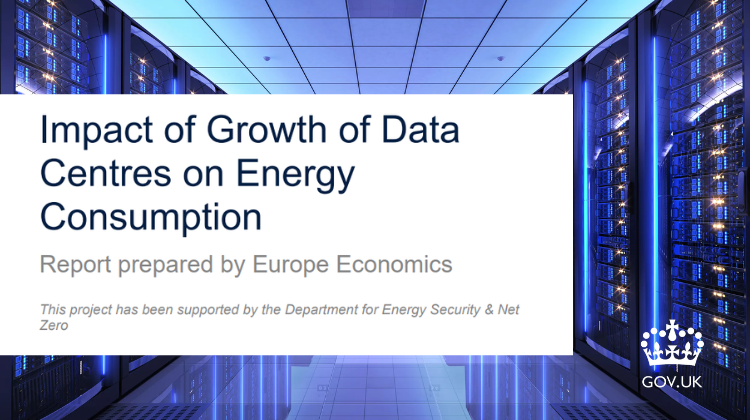This report examines how the growth of digital services, and the data centres that support them, affects energy consumption in the UK.
The expansion of data centres across Europe is reshaping electricity demand, creating both challenges and opportunities for the clean energy transition. A new study by Europe Economics, commissioned by the UK Department for Energy Security and Net Zero, assesses how digitalisation and the infrastructure that underpins it affect electricity consumption. While data centres add new, concentrated demand, digitalisation also displaces energy-intensive physical activities, offering a net efficiency gain when powered sustainably.
The report introduces a novel methodology for estimating electricity use by comparing digital services against physical alternatives under representative scenarios. The framework covers the entire delivery chain, including data centre IT and non-IT operations, transmission networks, and end-user devices. Three use cases were analysed: video streaming versus Blu-ray discs, eBook reading versus printed books, and AI-powered translation versus human office-based translation.
Video streaming vs. Blu-ray: In the central scenario, streaming consumed 1.05 kWh per film compared with 1.13 kWh for a UK-manufactured Blu-ray. If the Blu-ray is manufactured overseas, UK energy use falls to 0.66 kWh, as most production energy is consumed abroad.
eBooks vs. printed books: Downloading and reading an eBook consumed as little as 0.003 kWh, compared to 5.16 kWh for a UK-printed book. Even when manufactured overseas, physical books required 0.60 kWh, making digital consumption over 100 times more efficient.
AI translation vs. human translation: A single AI-powered translation task used less than 0.05 kWh, compared to more than 60 kWh for the equivalent human office-based task, and up to 120 kWh in high-use scenarios.
Importantly, the report does not provide an aggregate projection of how much total electricity will be needed to meet the overall growth of data centres. Instead, it focuses on case-by-case comparisons between digital and physical services, showing efficiency gains but without quantifying the cumulative demand that future data centre expansion may represent at national or European scale.
The scale and predictability of data centre demand position them as ideal offtakers for renewable generation. Long-term power purchase agreements (PPAs) with solar, wind, and storage developers are increasingly common, ensuring revenue stability for generators while helping operators meet decarbonisation goals. These partnerships can accelerate renewable deployment and strengthen system resilience.
Beyond consumption, data centres can contribute to grid flexibility. Through the integration of on-site renewables, deployment of battery storage, and participation in demand response schemes, they can act as stabilising forces within the electricity system. Hybrid models that combine renewables, storage, and digital demand are particularly effective in balancing variable generation with continuous consumption.
Efficiency improvements are evident, with new hyperscale facilities achieving Power Usage Effectiveness (PUE) ratios as low as 1.1, compared to 1.5 in less efficient legacy sites. This underscores the importance of regulatory frameworks such as the European Code of Conduct for Data Centre Energy Efficiency. Policymakers are encouraged to view data centres not only as major consumers but as strategic partners in advancing renewable integration and system decarbonisation.
The intersection of digitalisation and renewable energy represents a pivotal opportunity. Data centres, as concentrated demand hubs, can act as catalysts for renewable growth through PPAs, storage deployment, and flexibility services. Positioned at the core of Europe’s digital economy, they are uniquely placed to evolve as both enablers and beneficiaries of the clean energy transition.
